12 Great Perennials for Your Indiana Landscape
BY WHITNEY LEHNECKER | MAY 22ND, 2023 | INDIANA, LAWN CAREPerennials are a great way to add a yearly burst of color to any landscape, and in our temperate climate, there are many great ones to choose from. These 12 great perennials for your Indiana landscape are both beautiful and hardy enough to thrive here without a bunch of maintenance.
In this article:
- Black-Eyed Susan
- Giant Sunflower
- Shasta Daisy
- Wood Lily
- Butterfly Milkweed
- New England Aster
- Purple Coneflower
- Yarrow
- Cardinal Flower
- Garden Phlox
- Lance-Leaved Coreopsis
- Wild Bergamot
1. Black-Eyed Susan (Rudbeckia Hirta)
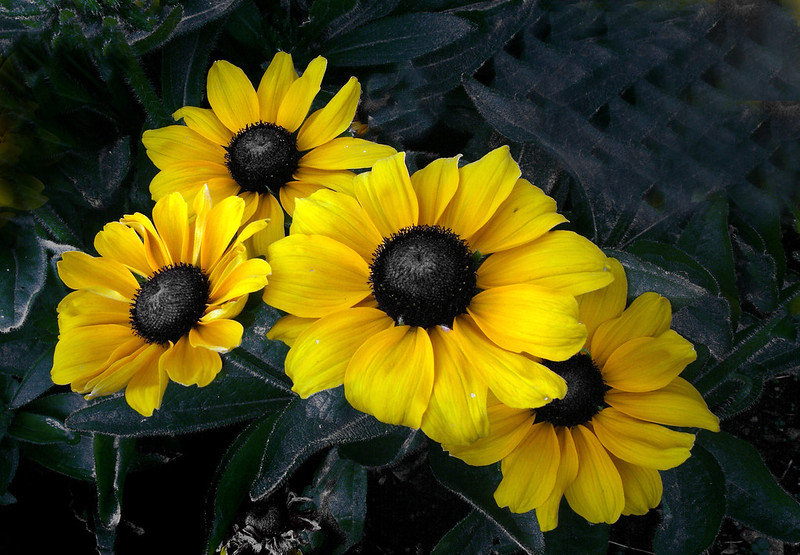
Photo Credit: Bernard Spragg / Flickr / CC0 1.0
Black-eyed Susan, also called yellow coneflower, is a striking flower because of the contrast between the dark button center and the brilliant yellow petals. For this reason, it’s popular in virtually every transition zone in the country. The Black-eyed Susan takes its time blooming, but once it does, it blooms for months. It looks stunning either on its own or combined with its purple counterpart. A bonus: bees, butterflies, and songbirds adore it.
Black-eyed Susan is easy to care for, adapts to a wide variety of conditions and stands up well to heat, drought, and cold. In short, it’s beautiful and tough.
- Sun: Full sun
- Soil: Clay, sand, loam, acidic, moist, well-drained
- Fragrance: Sweet
- Bloom time: Spring, summer, early autumn
- Water needs: Medium. It has moderate drought tolerance
- Mature height: 1 to 3 feet.
- Maintenance: Low. Can self-seed freely. Black-eyed Susan can become aggressive if given too perfect an environment and insufficient competition.
Potential hazards: Toxic
2. Giant Sunflower (Helianthus Giganteus)
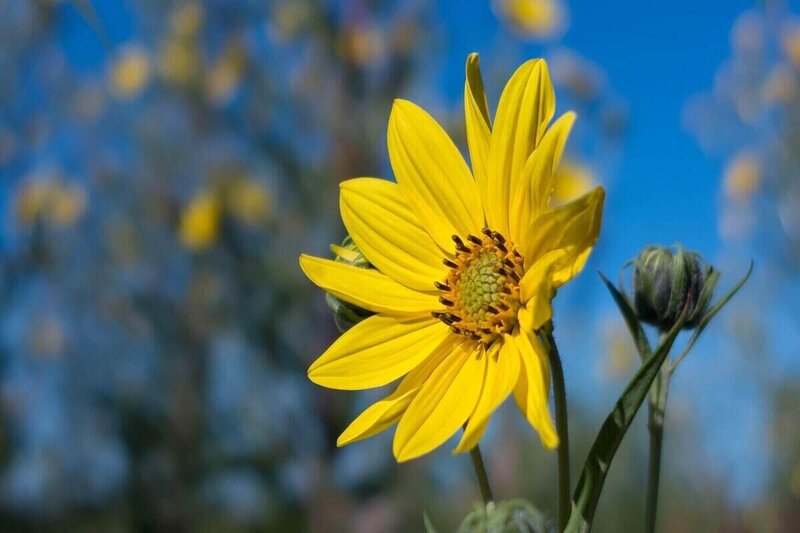
Photo Credit: Joe deSousa / Wikimedia Commons / CC0
As the name suggests, the giant sunflower is a real showstopper that grows up to 12 feet. This plant is easy to take care of and tolerates dry weather. Additionally, it’s a magnet for bees and a host for various butterfly species. Plus, its seeds are a common snack for birds.
However, be careful, because the giant sunflower is severely toxic to pets and various animals. It has some toxic effects on humans, too, if ingested.
- Sun: Full sun
- Soil: Rich, moist, well-draining soil with no rocks or tree roots
- Bloom time: Mid-summer to early fall
- Water needs: Drought tolerant; should get an inch of water per week
- Mature height: Up to 12 feet
- Maintenance: Low
- Potential hazards: Toxic
3. Shasta Daisy (Leucanthemum × Superbum)
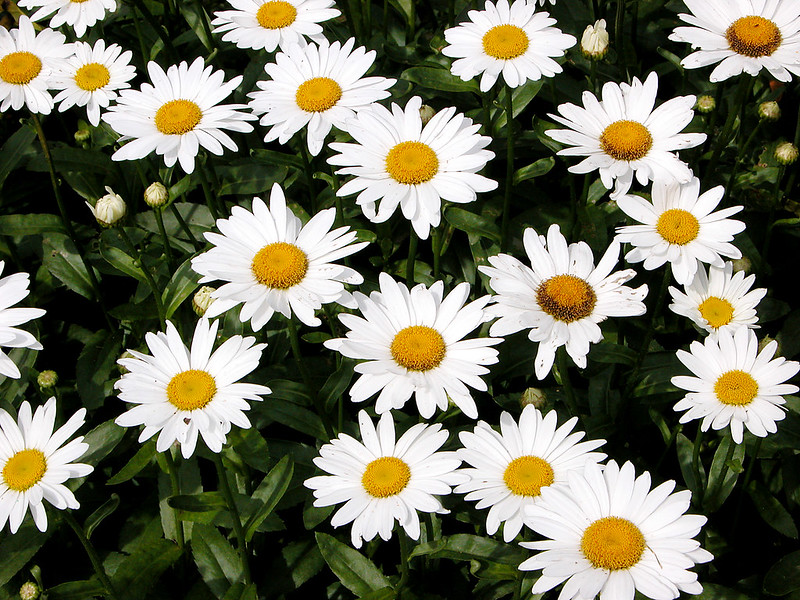
Photo Credit: Carl Lewis / Flickr / CC BY 2.0
The Shasta daisy is a lovely white daisy with a yellow center that blooms from mid-summer to early fall and goes dormant thereafter. It blooms better in full sun but can also withstand partial shade, and it needs about an inch of water per week.
As far as its effect on wildlife, butterflies love the Shasta daisy, and deer do not. In fact, deer may be repelled by it.
Mature size: Up to 4 feet tall and 2 feet wide
USDA hardiness zone: 4 to 9
Foliage: Dark green
Sunlight needs: Full sun to partial shade
Soil preferences: Loam, moist, well-drained soil
Water needs: Moderate
Potential hazards: Non-toxic to humans, toxic to pets
4. Wood Lily (Lilium Philadelphicum)
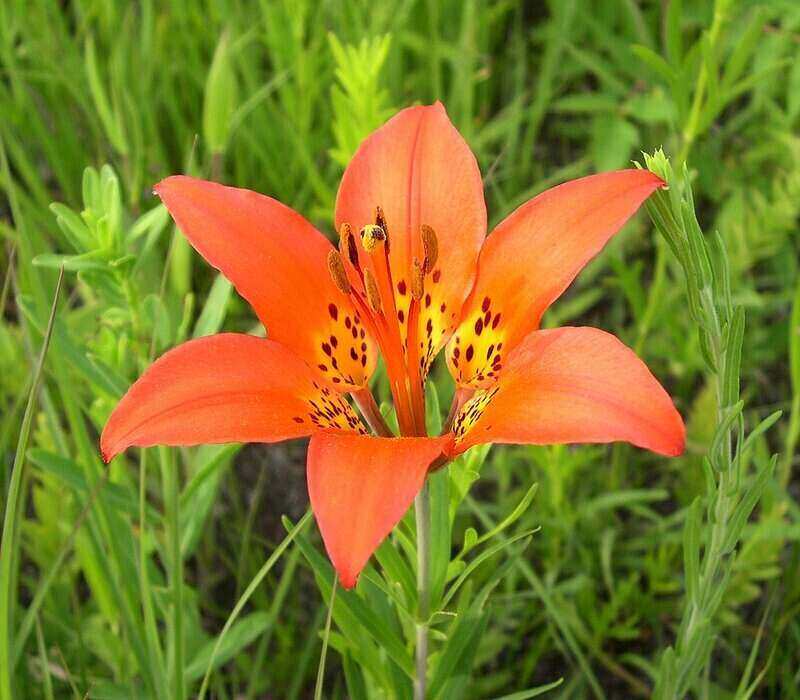
Photo Credit: Jay Sturner / Wikimedia Commons / CC BY 2.0
The wood lily sits on a 1 to 4-foot stalk and is topped by skyward-facing cup-shaped, reddish-orange flowers. There are usually one to four flowers per plant.
The showy blossoms make it a stunning addition to any landscape. The wood lily is great for attracting wildlife like hummingbirds, butterflies, and even rabbits.
- Sun: Full sun or partial shade
- Mature height: 1 to 2 feet
- Soil: Moist but well-drained
- Bloom time: Early to late summer
- Water needs: Frequent watering in the growing season and when the weather is dry
- Maintenance: Medium
- Potential hazards: Toxic
5. Butterfly Milkweed (Symphyotrichum Novae-Angliae)
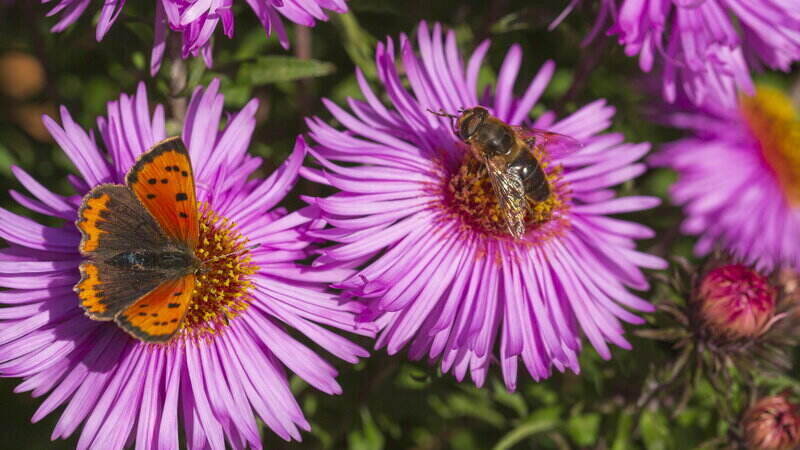
Photo Credit: PxFuel
What makes butterfly milkweed striking is its clusters of bright flowers atop its short stalk. It grows wild in the prairies and grasslands of the Midwest and Great Plains. Its hardy, tough nature means that it can survive in an array of climates and conditions, which is why it can be found from the New England states to the Southeast and even the desert of the Southwest U.S.
- Sun: Full sun
- Soil: Sandy, poor, average, dry to medium, well-drained
- Bloom time: Late spring to early fall
- Water needs: Low; depending on the weather, moderate watering should suffice
- Mature height: 1 to 2 feet
- Maintenance: Low
- Potential hazards: Toxic
6. New England Aster (Symphyotrichum Novae-Angliae)
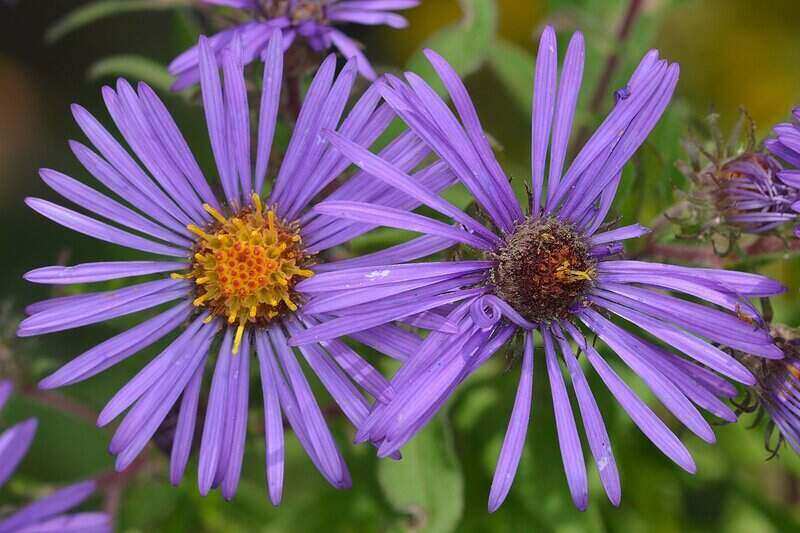
Photo Credit: Ryan Hodnett / Wikimedia Commons / CC BY-SA 4.0
The charming New England aster produces delicate, purple petals that add color and texture to any landscape. This plant also feeds wildlife like bees and butterflies, and it’s a great cut flower for arrangements. If you’re in the market for low-maintenance plant options, New England aster is great because it doesn’t need much water.
- Sun: Full sun to partial shade
- Soil: Clay, high organic matter, good drainage, moist, occasionally dry
- Bloom time: Late Summer and Fall
- Water needs: Water weekly or when the topmost layer of soil dries out
- Mature height: 3 to 7 feet
- Maintenance: Medium
Potential hazard: None known; caution is always advised, though
7. Purple Coneflower (Echinacea Purpurea)
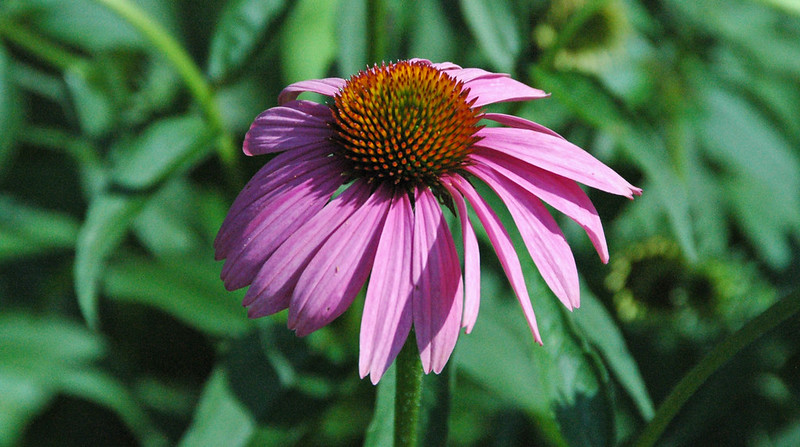
Photo Credit: James St. John / Flickr / CC BY 2.0
Where the wood lily forms a skyward-soaring cup, the purple coneflower has an odd downward-facing cone that gives it the appearance of a brightly colored badminton shuttlecock or birdie. Its pink-purple flowers are not only stunning to look at, but they attract wildlife such as butterflies, hummingbirds, and songbirds.
The only ding against the purple coneflower is that it is susceptible to diseases, so it’s not as carefree and easy as some other plants on this list..
- Sun: Full sun to partial shade
- Soil: Sandy, clay, rocky
- Bloom time: April to September
- Water needs: Medium
- Mature height: 2 to 5 feet
- Maintenance: Low
Potential hazards: Toxic
8. Yarrow (Achillea Millefolium)
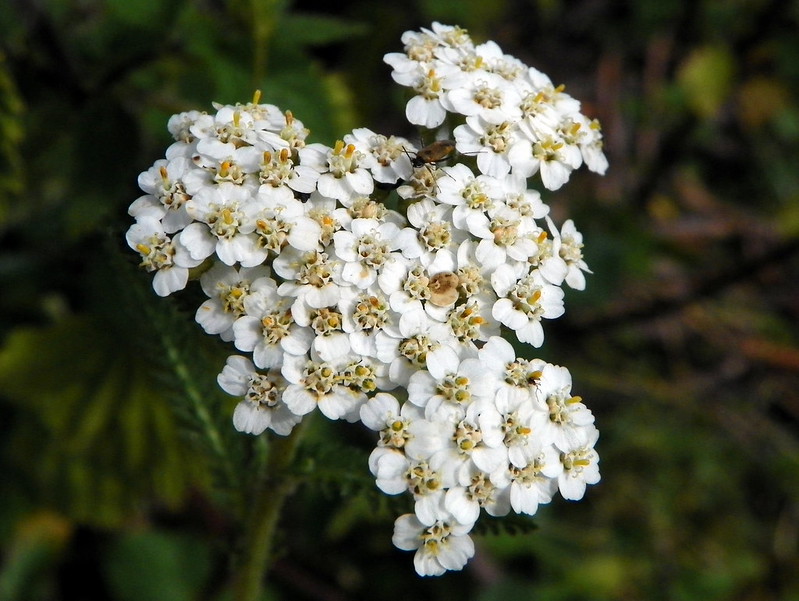
Photo Credit: Peter O’Connor / Flickr / CC BY-SA 2.0
Yarrow blooms from late spring to mid-fall, producing clusters of small, white, feathery flowers that attract bees and butterflies. It will flower even longer if you deadhead faded flowers.
It’s also a double threat in your garden: Not only is it pretty, but it’s a highly aromatic plant that gives your garden an amazing fragrance.
Yarrow requires frequent watering initially, but once established, it can survive with half an inch of watering a week. This plant isn’t bullet-proof, though. Yarrow is susceptible to botrytis mold and powdery mildew.
Mature size: Up to 3 feet tall and just as wide
USDA hardiness zone: 3 to 8
Foliage: Green
Sunlight needs: Full sun
Soil preferences: Sandy, clay, loam, well-drained soil
Water needs: Low
Potential hazards: Non-toxic to humans, toxic to pets
9. Cardinal Flower (Lobelia Cardinalis)
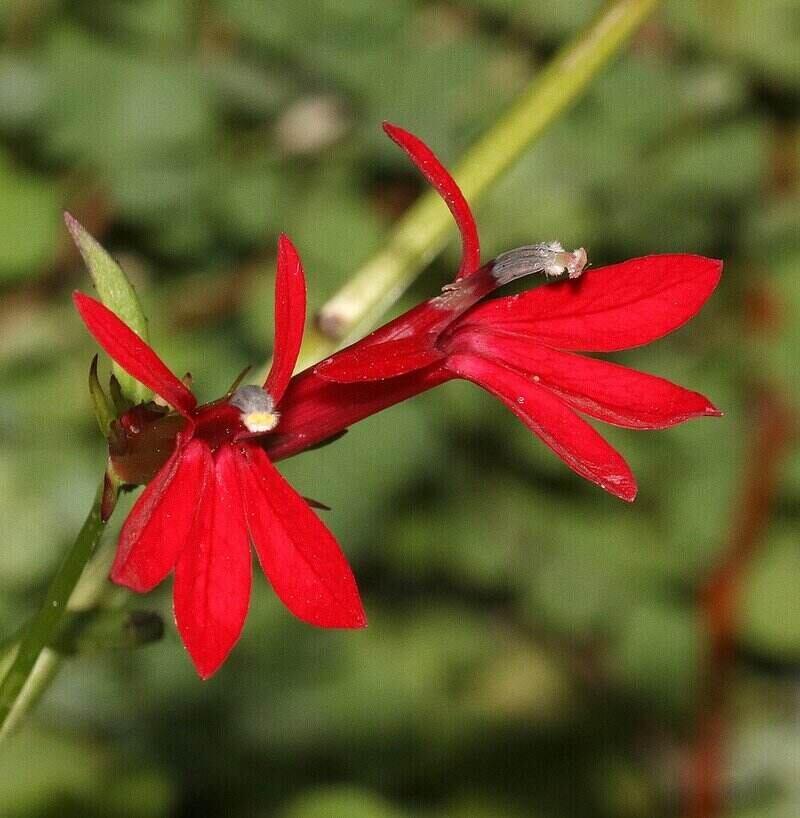
Photo Credit: ALAN SCHMIERER / Wikimedia Commons / CC0
The cardinal flower is named for the bright red robes worn by Roman Catholic cardinals, so it’s no coincidence that the most striking feature of this plant is its vibrant red petals. Found throughout the United States and as far north as Canada and all the way down to Mexico, it loves moist soils, including wet woodlands, streambanks, swamps and marshy areas. This makes it perfect for a rain garden.
Although it needs frequent watering, cardinal flower is otherwise easy to care for. Plus, butterflies like to snack on the flower’s nectar.
- Sun: Full sun, partial shade, full shade
- Soil: Sand, loam, clay, limestone-based
- Bloom time: July to October
- Water needs: Medium to high
- Mature height: 1 to 6 feet
- Maintenance: Low
- Potential hazards: Toxic
10. Garden Phlox (Phlox Paniculata)
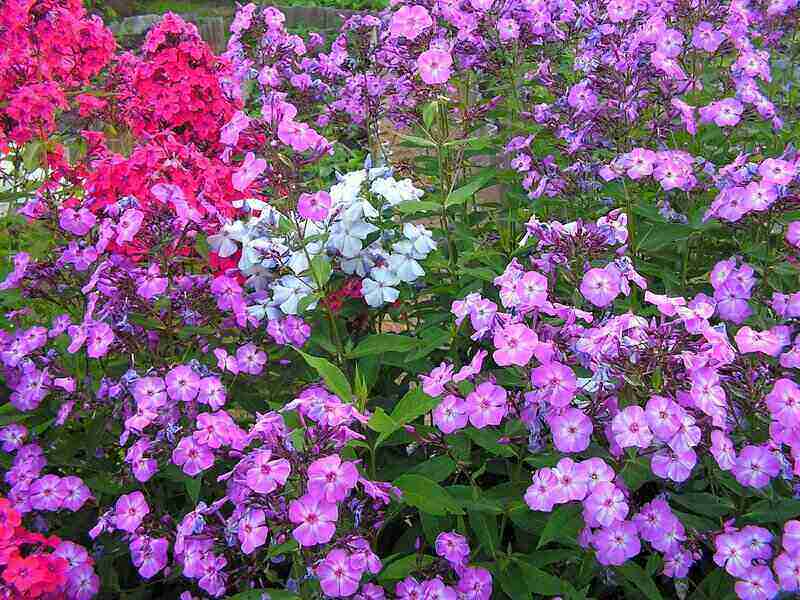
Photo Credit: Bff / Wikimedia Commons / CC BY-SA 3.0
Garden phlox is a moderately tall perennial that grows wild in forests, woodlands, prairies, and other natural habitats. It sprouts pink, purple, or white clusters atop 3 to 4-foot stems and makes any landscape a head-turner.
The only downside to garden phlox is that it is vulnerable to insect damage and diseases, including powdery mildew, so it needs some attention.
- Sun: Full sun to partial shade
- Soil: Clay, loam, high organic matter, good drainage, moist
- Bloom time: Mid-summer to mid-fall
- Water needs: Water in dry summers. Avoid overhead watering.
- Mature height: 2 to 4 feet
- Maintenance: Medium
Potential hazards: None known (lack of data); caution is always advised
11. Lance-Leaved Coreopsis (Coreopsis Lanceolata)
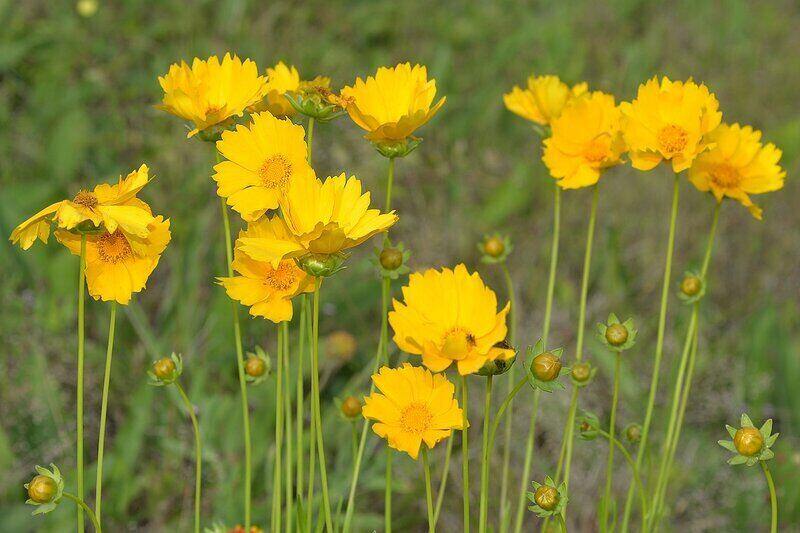
Photo Credit: William L. Farr / Wikimedia Commons / CC BY-SA 4.0
Lance-leaved coreopsis, also called tickseed, is a low-maintenance plant that bathes your yard in hues of brilliant yellow. It grows up to three feet tall, and its large flowers can reach 3 to 4 inches in diameter.
Like many of the other plants on this list, lance-leaved coreopsis is tough. It does fine in dry, hot, and humid weather. The plant itself is a perennial that stays green for a long time, although the flowers have a relatively short duration.
- Sun: Full sun
- Soil: Loamy, sandy, dry to medium moisture, well-drained; ideally poor, sandy or rocky soils
- Bloom time: Late spring to mid summer
Water needs: Drought-tolerant; but will benefit from regular watering, especially when soil is dry; needs regular watering before it’s established - Mature height: 1 to 3 feet
- Maintenance: Low
Potential hazards: Some reports of toxicity
12. Wild Bergamot (Monarda Fistulosa)
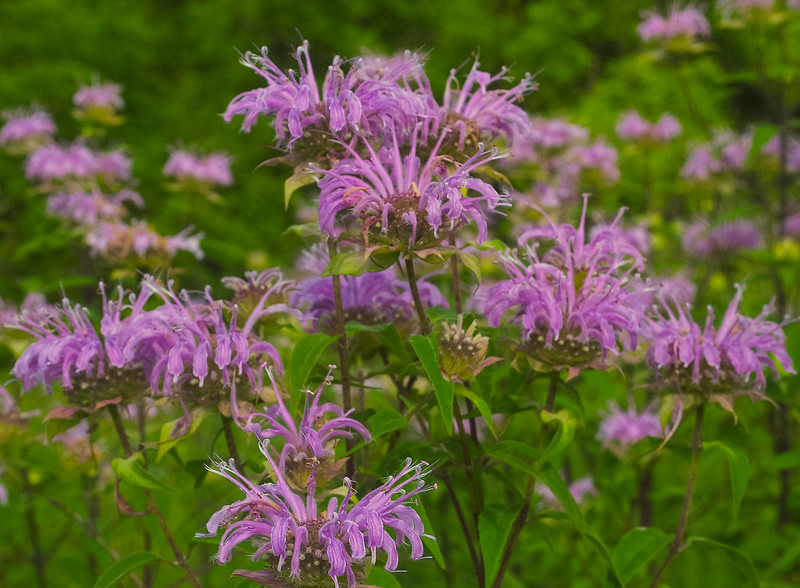
Photo Credit: Joshua Mayer / Flickr / CC BY-SA 2.0
If you like showy, fragrant flowers, you’re in for a treat. Wild bergamot is an atypical pink, purple, or white perennial in the bee balm family that smells like a mix of mint and oregano. Because it’s a wildflower, wild bergamot doesn’t take too much care for it to grow well in your yard. Moreover, it attracts various bees, butterflies, and hummingbirds.
- Soil: Full sun or partial shade
- Soil: Well-drained but moist, sandy loam, loam, or clay soil; adapts to various soil types
- Bloom time: Late spring to mid fall
Water needs: Needs to be watered once per week when the weather gets hot - Mature height: Up to 5 feet
- Maintenance: Low
Potential hazards: Consuming this plant poses some serious risks for pregnant women, nursing women, and children; excessive consumption is unsafe for pets; practice caution
FAQ
While annual plants live for one season, perennial plants grow year after year. However, annuals are known for their vibrant colors, and some of them self-seed.
It’s best to plant perennials in fall or spring, but you can plant them at any time of the year before the ground freezes.
Final Thoughts
Perennials are popular additions to most gardens because they have the dual benefit of being beautiful and, well, perennial; they return year after year. Most of them are pretty hardy as well. They thrive in a variety of pretty tough conditions and climates, so they certainly do well in the temperate climate of Indiana.
But choosing the right plants is only the first step to creating a beautiful yard. You also need to care for it. If you’d like some help, Wikilawn’s lawn care pros are available to do the dirty work for you. Get a quote here.
Main Photo By: PixaBay